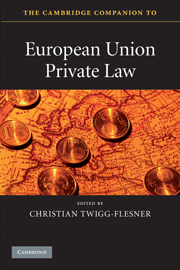Book contents
- Frontmatter
- Contents
- Preface
- List of Contributors
- Table of cases
- Table of legislation
- 1 Introduction
- 2 The historical evolution of European private law
- 3 European private law and the comparative method
- 4 The role of the conflict of laws in European private law
- 5 Competence and European private law
- 6 Language and terminology
- 7 European private law by directives
- 8 The European Court of Justice as a motor of private law
- 9 European contract law
- 10 The way forward in European consumer contract law
- 11 Commercial contracts and European private law
- 12 European tort law
- 13 European Union property law
- 14 Information obligations and withdrawal rights
- 15 Travel law
- 16 Unfair contract terms
- 17 Unfair commercial practices and European private law
- 18 Consumer sales and associated guarantees
- 19 Product liability
- 20 Commercial agency in European Union private law
- 21 EU competition law and European private law
- 22 Non-discrimination and European private law
- 23 Financial services in European Union private law
- Further reading
- Index
4 - The role of the conflict of laws in European private law
Published online by Cambridge University Press: 05 July 2015
- Frontmatter
- Contents
- Preface
- List of Contributors
- Table of cases
- Table of legislation
- 1 Introduction
- 2 The historical evolution of European private law
- 3 European private law and the comparative method
- 4 The role of the conflict of laws in European private law
- 5 Competence and European private law
- 6 Language and terminology
- 7 European private law by directives
- 8 The European Court of Justice as a motor of private law
- 9 European contract law
- 10 The way forward in European consumer contract law
- 11 Commercial contracts and European private law
- 12 European tort law
- 13 European Union property law
- 14 Information obligations and withdrawal rights
- 15 Travel law
- 16 Unfair contract terms
- 17 Unfair commercial practices and European private law
- 18 Consumer sales and associated guarantees
- 19 Product liability
- 20 Commercial agency in European Union private law
- 21 EU competition law and European private law
- 22 Non-discrimination and European private law
- 23 Financial services in European Union private law
- Further reading
- Index
Summary
Introduction
According to a very basic definition, private international law determines decisional or adjudicatory jurisdiction (whether that of the courts or of an administrative authority), the applicable law and the conditions of enforcement of foreign judgments in cases which have multiple connections with different countries. The term ‘conflict of laws’ (or the more contemporary American ‘choice of law’) will be used here as an alternative to the more venerable ‘private international law’, which suggests both internationality and ‘privateness’. While there are arguably more international sources of choice of law and jurisdictional rules today than ever before, many of these may, in fact, emerge from European Community instruments, making ‘international’ inappropriate to describe quasi-federal type of conflicts, which call for a distinct approach, as will be seen. Moreover, the public–private divide, at least as it was traditionally conceived, is losing hold in European substantive law and is now no longer apt to describe the new categories of conflict of laws which are emerging before the courts.
Traditional European conceptions of the function of the conflict of laws are currently undergoing considerable change, which has been likened by observers from across the Atlantic to the American methodological revolution which took place in the 1960s and led to the abandonment of the multilateral choice of law rules which, to a large extent, Europe still favours. These are rules which connect a category of legal issues (usually defined by reference to the forum’s own private law taxonomy) to the legal system that appears ex ante to entertain the most significant relationship with them. Thus, issues relating to torts were subjected traditionally to the law of the place of the tort (lex loci delicti). The rule survives in Europe, subject to exceptions, in the form of the law of the place of the tortious harm, under the Rome-II Regulation (Regulation 864/2007).
- Type
- Chapter
- Information
- The Cambridge Companion to European Union Private Law , pp. 44 - 57Publisher: Cambridge University PressPrint publication year: 2010
- 1
- Cited by



